-
Which of the following statements is true?
a.
Scalar quantities display both magnitude and direction of force.
b.
Vector quantities display both magnitude and direction of force.
c.
Both a. and b. are true.
d.
Neither a. or b. is true.
The correct answer is: Vector quantities display both magnitude and direction of force.
-
The magnitude of both scalar and vector quantities are represented by the ? of a line.
a.
color
b.
direction
c.
length
d.
all of the above
The correct answer is: length
-
A vector that has the initial point at (0, 0) is in the ? position.
a.
minimum
b.
neutral
c.
standard
d.
zero
The correct answer is: standard
-
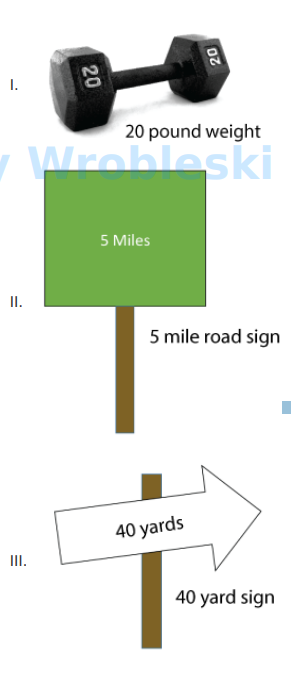
Which of the following is a scalar quantity and not a vector?
I.
II.
III.
a.
I. and II.
b.
I. and III.
c.
II. And III.
d.
II.
e.
I.
f.
III.
The correct answer is: II.
-
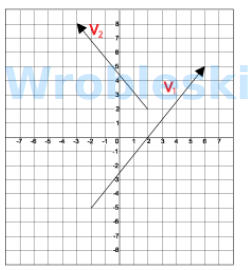
Determine the initial and terminal points of vector V .
Click on the image to view a larger version of it.
a.
Initial point (-5, -2), terminal point (5, 6)
b.
Initial point (-2, -5), terminal point (6, 5)
c.
Initial point (5, 6), terminal point (-5, -2)
d.
Initial point (6, 5), terminal point (-2, -5)
The correct answer is: Initial point (-2, -5), terminal point (6, 5)
-
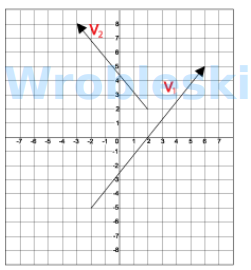
Determine the initial and terminal points of vector V .
Click on the image to view a larger version of it.
a.
Initial point (-8, 3), terminal point (-2, 2)
b.
Initial point (-3, 8), terminal point (-2, 2)
c.
Initial point (-2, 2), terminal point (-3, 8)
d.
Initial point (2, 2), terminal point (-3, 8)
The correct answer is: Initial point (2, 2), terminal point (-3, 8)
-
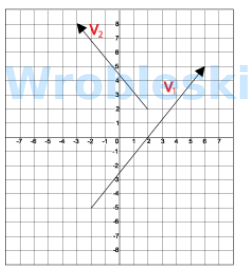
Write the vector V in component form.
Click on the image to view a larger version of it.
a.
x = -10, y = -8
b.
x = -8, y = -10
c.
x = 8, y = 10
d.
x = 10, y = 8
The correct answer is: x = 8, y = 10
-

Write the vector V in component form.
Click on the image to view a larger version of it.
a.
x = -6, y = -5
b.
x = -5, y = -6
c.
x = -5, y = 6
d.
x = 5, y = 6
The correct answer is: x = -5, y = 6
-
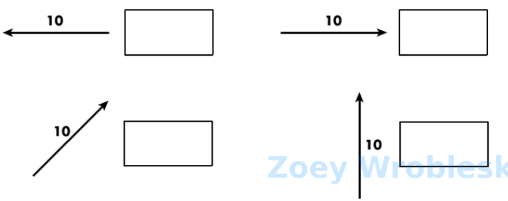
Each of the vectors below have a magnitude of 10. Drag the appropriate angle value to the space next to
the correct vector to indicate it’s direction.
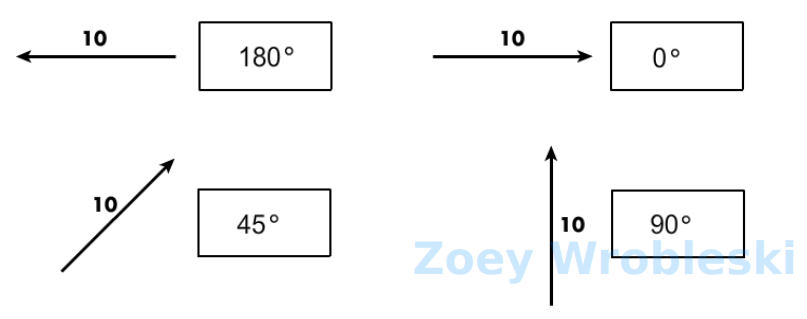
-
A single vector produced from combining two or more vectors is called the ? .
a.
adder
b.
resultant
c.
sum
d.
trajectory
The correct answer is: resultant
-
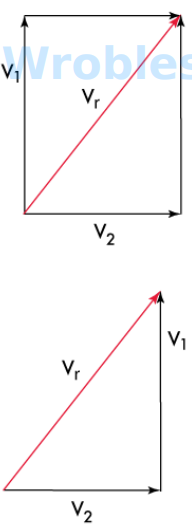
Match the name of the method shown for solving for two vectors at right angles to each other next to the
images below.
possible answers
Triangle Method
Parallelogram Method
The correct answer is:
Parallelogram Method
Triangle Method
-
From 0° on the X (horizontal) axis, the positive vector angle positions are rotated in the ? direction.
a.
clockwise
b.
counterclockwise
The correct answer is: counterclockwise
-
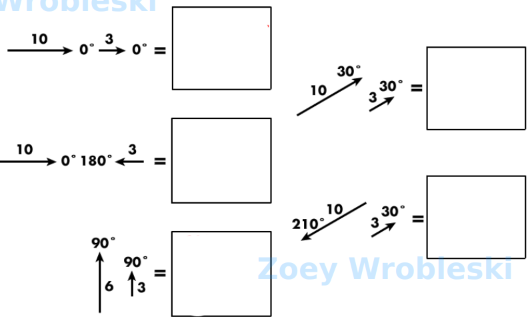
Combine each pair of the following vectors to form a single vector for each pair. Drag the appropriate
resultant vectors below into the box next to the pair that were combined.
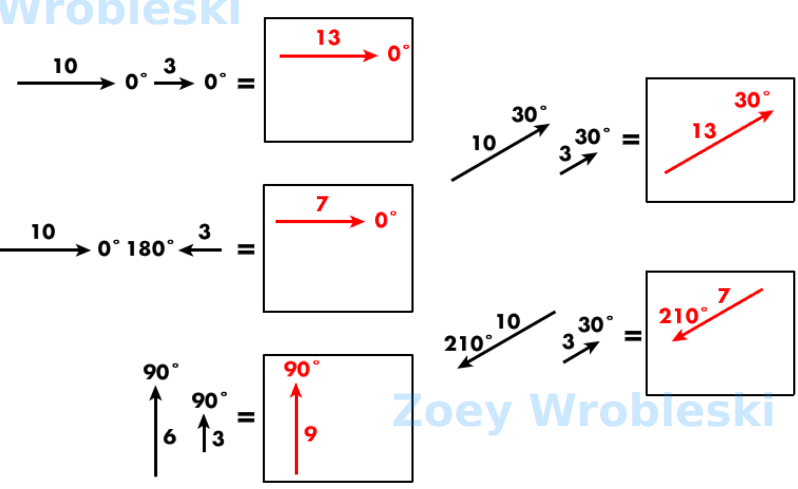
-
Vectors can be ? using the parallelogram method.
a.
added
b.
divided
c.
multiplied
d.
subtracted
The correct answer is: added
-
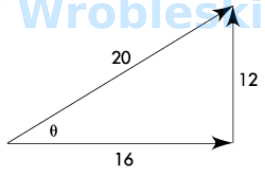
Determine the sine of angle theta. (Round the FINAL answer to one decimal place.)
Answer:
The correct answer is: 0.6
-
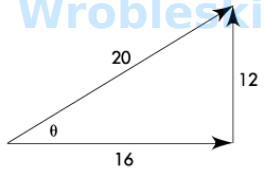
Determine the cosine of angle theta. (Round the FINAL answer to one decimal place.)
Answer:
The correct answer is: 0.8
-
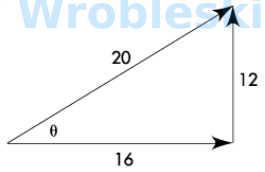
Determine the tangent of angle theta. (Round the FINAL answer to two decimal places.)
Answer:
The correct answer is: 0.75
-
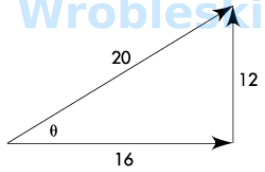
Determine the angle theta. (Round the FINAL answer to two decimal places.)
Answer:
°
The correct answer is: 36.87
-
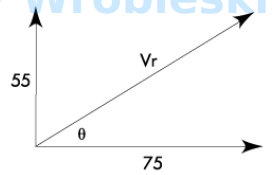
Use the Pythagorean Theorem to determine the value of the resultant V for the two vectors shown. (Round
the FINAL answer to the nearest whole number.)
Answer:
The correct answer is: 93
-
To determine a vector's X (horizontal) and Y (vertical) components when the magnitude and direction
(angle) are known, one typically uses the function ? to find the X and ? to find the Y components.
a.
sine / cosine
b.
cosine / sine
c.
tangent / sine
d.
cosine / tangent
The correct answer is: cosine / sine
-
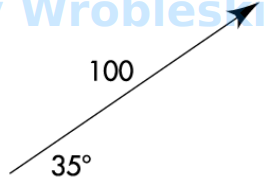
Reduce the vector shown to its (X) horizontal component. (Round the FINAL answer to two decimal places.)
Answer:
The correct answer is: 81.92
-
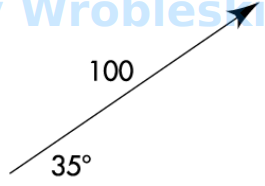
Reduce the vector shown to it’s (Y) vertical component. (Round the FINAL answer to two decimal places.)
Answer:
The correct answer is: 57.36
-

To add the six
vectors you will first find the horizontal and vertical components of each vector. The next step will be to
combine like vertical and horizontal values vectorially where then you can apply the Pythagorean Theorem
to determine a single equivalent resultant vector. Use the table to track your progress.
Calculate the vertical component of vector V .
The correct answer is: 0
-

For this question you will be working to determine a single, equivalent resultant vector. To add the six
vectors you will first find the horizontal and vertical components of each vector. The next step will be to
combine like vertical and horizontal values vectorially where then you can apply the Pythagorean Theorem
to determine a single equivalent resultant vector. Use the table to track your progress.
Calculate the horizontal component of vector V
The correct answer is: 10
-

For this question you will be working to determine a single, equivalent resultant vector. To add the six
vectors you will first find the horizontal and vertical components of each vector. The next step will be to
combine like vertical and horizontal values vectorially where then you can apply the Pythagorean Theorem
to determine a single equivalent resultant vector. Use the table to track your progress.
Calculate the vertical component of vector V .
The correct answer is: 10
-

For this question you will be working to determine a single, equivalent resultant vector. To add the six
vectors you will first find the horizontal and vertical components of each vector. The next step will be to
combine like vertical and horizontal values vectorially where then you can apply the Pythagorean Theorem
to determine a single equivalent resultant vector. Use the table to track your progress.
Calculate the horizontal component of vector V
The correct answer is: 0
-

For this question you will be working to determine a single, equivalent resultant vector. To add the six
vectors you will first find the horizontal and vertical components of each vector. The next step will be to
combine like vertical and horizontal values vectorially where then you can apply the Pythagorean Theorem
to determine a single equivalent resultant vector. Use the table to track your progress.
Calculate the vertical component of vector V .
The correct answer is: 0
-

For this question you will be working to determine a single, equivalent resultant vector. To add the six
vectors you will first find the horizontal and vertical components of each vector. The next step will be to
combine like vertical and horizontal values vectorially where then you can apply the Pythagorean Theorem
to determine a single equivalent resultant vector. Use the table to track your progress.
Calculate the horizontal component of vector V .
The correct answer is: -4
-

For this question you will be working to determine a single, equivalent resultant vector. To add the six
vectors you will first find the horizontal and vertical components of each vector. The next step will be to
combine like vertical and horizontal values vectorially where then you can apply the Pythagorean Theorem
to determine a single equivalent resultant vector. Use the table to track your progress.
Calculate the vertical component of vector V .
The correct answer is: -6
-

For this question you will be working to determine a single, equivalent resultant vector. To add the six
vectors you will first find the horizontal and vertical components of each vector. The next step will be to
combine like vertical and horizontal values vectorially where then you can apply the Pythagorean Theorem
to determine a single equivalent resultant vector. Use the table to track your progress.
Calculate the horizontal component of vector V
The correct answer is: 0
-

For this question you will be working to determine a single, equivalent resultant vector. To add the six
vectors you will first find the horizontal and vertical components of each vector. The next step will be to
combine like vertical and horizontal values vectorially where then you can apply the Pythagorean Theorem
to determine a single equivalent resultant vector. Use the table to track your progress.
Calculate the vertical component of vector V . (Round the FINAL answer to two decimal places.)
The correct answer is: 8.66
-

For this question you will be working to determine a single, equivalent resultant vector. To add the six
vectors you will first find the horizontal and vertical components of each vector. The next step will be to
combine like vertical and horizontal values vectorially where then you can apply the Pythagorean Theorem
to determine a single equivalent resultant vector. Use the table to track your progress.
Calculate the horizontal component of vector V .
The correct answer is: 5
-

For this question you will be working to determine a single, equivalent resultant vector. To add the six
vectors you will first find the horizontal and vertical components of each vector. The next step will be to
combine like vertical and horizontal values vectorially where then you can apply the Pythagorean Theorem
to determine a single equivalent resultant vector. Use the table to track your progress.
Calculate the vertical component of vector V .
The correct answer is: -5
-

For this question you will be working to determine a single, equivalent resultant vector. To add the six
vectors you will first find the horizontal and vertical components of each vector. The next step will be to
combine like vertical and horizontal values vectorially where then you can apply the Pythagorean Theorem
to determine a single equivalent resultant vector. Use the table to track your progress.
Calculate the horizontal component of vector V . (Round the FINAL answer to two decimal places.)
The correct answer is: 8.66
-

For this question you will be working to determine a single, equivalent resultant vector. To add the six
vectors you will first find the horizontal and vertical components of each vector. The next step will be to
combine like vertical and horizontal values vectorially where then you can apply the Pythagorean Theorem
to determine a single equivalent resultant vector. Use the table to track your progress.
Combine the calculated vertical components adding them vectorially. (Round the FINAL answer to two
decimal places.)
The correct answer is: 7.66
-

For this question you will be working to determine a single, equivalent resultant vector. To add the six
vectors you will first find the horizontal and vertical components of each vector. The next step will be to
combine like vertical and horizontal values vectorially where then you can apply the Pythagorean Theorem
to determine a single equivalent resultant vector. Use the table to track your progress.
Combine the calculated horizontal components adding them vectorially. (Round the FINAL answer to two
decimal places.)
The correct answer is: 19.66
-

For this question you will be working to determine a single, equivalent resultant vector. To add the six
vectors you will first find the horizontal and vertical components of each vector. The next step will be to
combine like vertical and horizontal values vectorially where then you can apply the Pythagorean Theorem
to determine a single equivalent resultant vector. Use the table to track your progress.
Use the Pythagorean Theorem and calculate the magnitude of the resultant vector. (Round the FINAL
answer to one decimal place.)
The correct answer is: 21.1
-

For this question you will be working to determine a single, equivalent resultant vector. To add the six
vectors you will first find the horizontal and vertical components of each vector. The next step will be to
combine like vertical and horizontal values vectorially where then you can apply the Pythagorean Theorem
to determine a single equivalent resultant vector. Use the table to track your progress.
Find the angle theta for the resultant vector. (Round the FINAL answer to one decimal place.)
The correct answer is: 21.3


